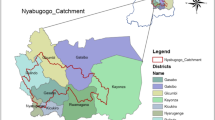Abstract
Suzhou is one of China’s most developed regions, located in the eastern part of the Yangtze Delta. Due to its location and river features, it may at a high risk of flood under the climate change background in the future. In order to investigate the flood response to the extreme scenario in this region, 1-D hydrodynamic model with real-time operations of sluices and pumps is established. The rain-runoff processes of the urban and rural areas are simulated by two lumped hydrologic models, respectively. Indicators for a quantitative assessment of the flood severity in this region are proposed. The results indicate that the existing flood control system could prevent the Suzhou Downtown from inundation in the future. The difficulty of draining the Taihu Lake floods should be given attention to avoid the flood hazard. The modelling approach based on the in-bank model and the evaluation parameters could be effective for the flood severity estimation in the plain river network catchment. The insights from this study of the possible future extreme flood events may assist the policy making and the flood control planning.
Similar content being viewed by others
References
Gong Z., Zhang C. K., Wan L. M. et al. Tidal level response to sea-level rise in the Yangtze Estuary [J]. China Ocean Engineering, 2012, 26(1): 109–122.
Pachauri R. K., Meyer L., Plattner G. K. et al. IPCC, 2014: Climate Change 2014: Synthesis Report. Contribution of Working Groups I, II and III to the Fifth Assessment Report of the Intergovernmental Panel on Climate Change[R]. IPCC, 2015.
Han L. F., Xu Y. P., Pan G. B. et al. Changing properties of precipitation extremes in the urban areas, Yangtze River Delta, China, during 1957–2013 [J]. Natural Hazards, 2015, 79(1): 437–454.
Zhang Q., Xu C. Y., Zhang Z. et al. Spatial and temporal variability of precipitation maxima during 1960–2005 in the Yangtze River basin and possible association with large-scale circulation [J]. Journal of Hydrology, 2008, 353(3): 215–227.
Mendizabal M., Sepúlveda J., Torp P. Climate change impacts on flood events and its consequences on human in Deba River [J]. International Journal of Environmental Research, 2014, 8(1): 221–230.
Milly P., Wetherald R., Dunne K. et al. Increasing risk of great floods in a changing climate [J]. Nature, 2002, 415(6871): 514–517.
Hirabayashi Y., Mahendran R., Koirala S. et al. Global flood risk under climate change [J]. Nature Climate Change, 2013, 3(9): 816–821.
Hunt A., Watkiss P. Climate change impacts and adaptation in cities: A review of the literature [J]. Climatic Change, 2011, 104(1): 13–49.
Han S. Q., Xie Y. Y., Li D. M. et al. Risk analysis and management of urban rainstorm water logging in Tianjin [J]. Journal of Hydrodynamics, Ser. B, 2006, 18(5): 552–558.
Liu L., Xu Z. X., Reynard N. S. et al. Hydrological analysis for water level projections in Taihu Lake, China [J]. Journal of Flood Risk Management, 2013, 6(1): 14–22.
Liang Q., Smith L., Xia X. New prospects for com putational hydraulics by leveraging high-performance heterogeneous computing techniques [J]. Journal of Hydrodynamics, 2016, 28(6): 977–985.
Wicks J. M., Hu C., Scott M. et al. A broad scale model for flood simulation in the Taihu Basin, China [J]. Journal of Flood Risk Management, 2013, 6(1): 33–41.
Xu Z. X., Liu L. Detection of climate change and projection of future climate change scenarios in Taihu Lake Basin [J]. Advances in Science and Technology of Water Resources, 2012, 32(1): 1–7.
Yu C., Hall J. W., Cheng X. et al. Broad scale quantified flood risk analysis in the Taihu Basin, China [J]. Journal of Flood Risk Management, 2013, 6(1): 57–68.
Cheng X. T., Evans E. P., Wu H. Y. et al. A framework for long-term scenario analysis in the Taihu Basin, China [J]. Journal of Flood Risk Management, 2013, 6(1): 3–13.
Ou Y., Wu H. The Taihu Basin flood in 1999 [M]. Beijing, China: China Water and Power Press, 2001 (in Chinese).
Li J. Sea level variation and its effect on storm surge in the East China Sea [D]. Master Thesis, Qingdao, China: Ocean University of China, 2011(in Chinese).
Li S. L., Han L., Bian J. Projecting heavy rainfall events in the middle and lower reach of the Yangtze River valley in the 21st century based on IPCC AR4 simulations [J]. Torrential Rain and Disasters, 2012, 31(3): 193–200(in Chinese).
Mishra V., Ganguly A. R., Nijssen B. et al. Changes in observed climate extremes in global urban areas [J]. Environmental Research Letters, 2015, 10(2): 024005.
Alfieri L., Thielen J. A European precipitation index for extreme rain-storm and flash flood early warning [J]. Meteorological Applications, 2015, 22(1): 3–13.
Kriebel D. L., Geiman J. D., Henderson G. R. Future flood frequency under sea-level rise scenarios [J]. Journal of Coastal Research, 2005, 31(5): 1078–1083.
Lin B. X., Su X. G. Optimal dispatching of flood control system for sluice groups in plain dike areas [J]. Journal of Zhejiang University (Natural Science), 1996, 30(6): 652–663(in Chinese).
Sabzi H. Z., Humberson D., Abudu S. et al. Optimization of adaptive fuzzy logic controller using novel combined evolutionary algorithms, and its application in Diez Lagos flood controlling system, Southern New Mexico [J]. Expert Systems with Applications, 2016, 43(C): 154–164.
Haddad O. B., Ashofteh P. S., Mariño M. A. Levee layouts and design optimization in protection of flood areas [J]. Journal of Irrigation and Drainage Engineering, 2015, 141(8): 04015004
Gu Z. H., Cao X. M., Liu G. L. et al. Optimizing operation rules of sluices in river networks based on knowledge-driven and data-driven mechanism [J]. Water Resources Management, 2014, 28(11): 3455–3469.
Author information
Authors and Affiliations
Corresponding author
Additional information
Project supported by the National Key Research and Development Program of China (Grant No. 2017Yfc0405600, 2016Yfc0401503), the Special Fund for Public Welfare of Water Resources Ministry (Grant No. 201501007, 201201017) and the State Key Program of National Natural Science of China (Grant No. 51239003).
Biography: Zi-jun Hu (1988-), Male, Ph. D. Corresponding author: Ling-ling Wang
Rights and permissions
About this article
Cite this article
Hu, Zj., Wang, Ll., Tang, Hw. et al. Prediction of the future flood severity in plain river network region based on numerical model: A case study. J Hydrodyn 29, 586–595 (2017). https://doi.org/10.1016/S1001-6058(16)60771-0
Received:
Revised:
Published:
Issue Date:
DOI: https://doi.org/10.1016/S1001-6058(16)60771-0




